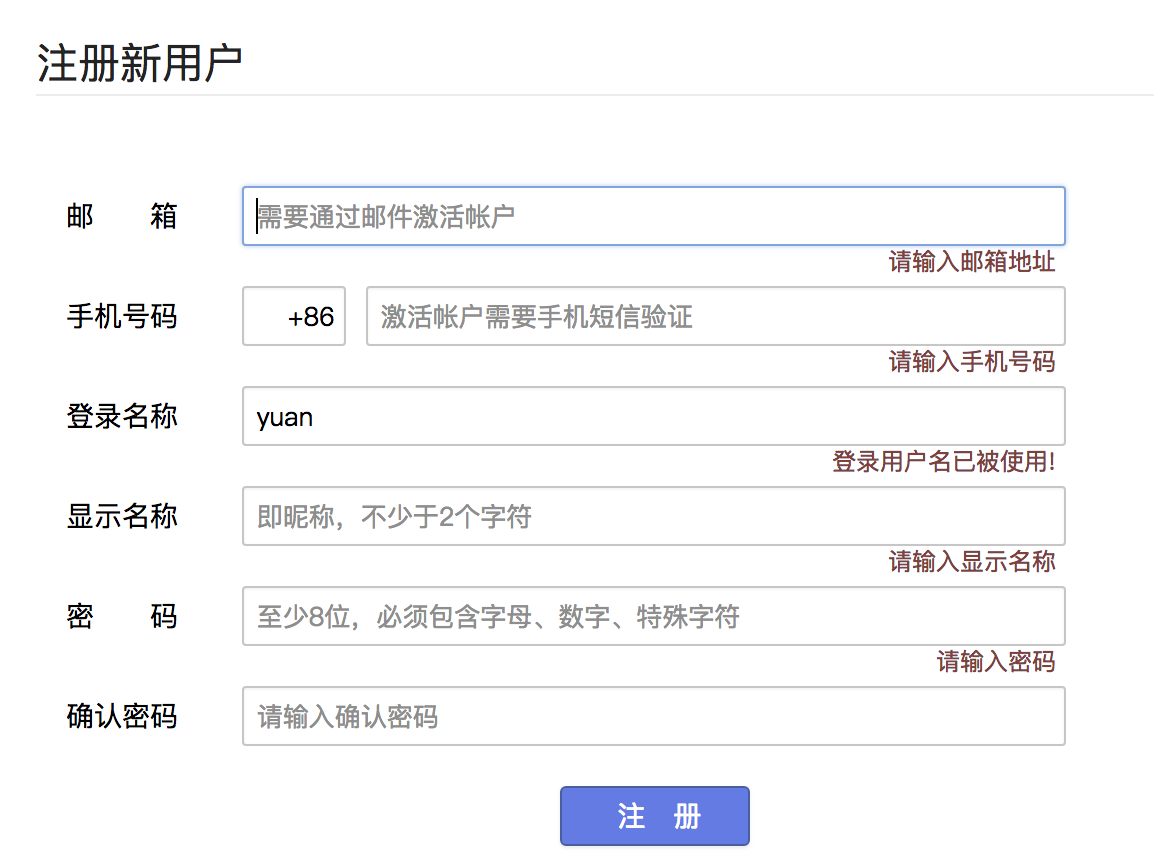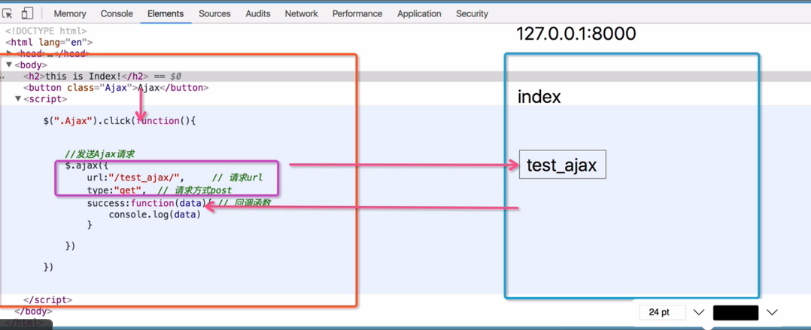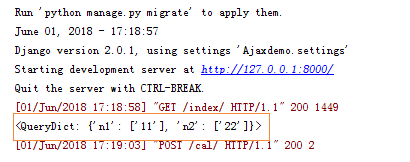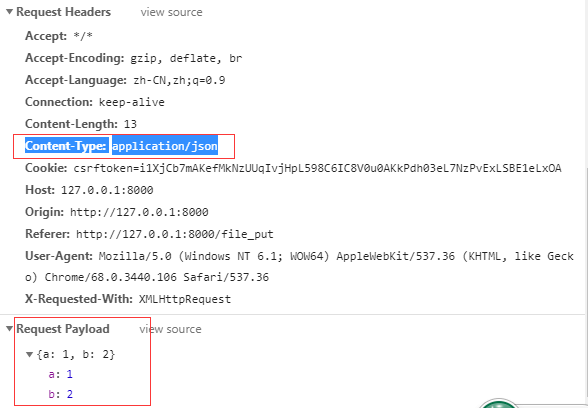6.Django与Ajax
Ajax
文件夹为Ajaxdemo
向服务器发送请求的途径:
1.浏览器地址栏,默认get请求;
2.form表单:
get请求
post请求
3.a标签,超链接(get请求)
4.Ajax请求
特点:1异步请求;2局部刷新
get
post
AJAX(Asynchronous Javascript And XML)翻译成中文就是“异步Javascript和XML”。即使用Javascript语言与服务器进行异步交互,传输的数据为XML(当然,传输的数据不只是XML,现在更多使用json数据)。
- 同步交互:客户端发出一个请求后,需要等待服务器响应结束后,才能发出第二个请求;
- 异步交互:客户端发出一个请求后,无需等待服务器响应结束,就可以发出第二个请求。
AJAX除了异步的特点外,还有一个就是:浏览器页面局部刷新;(这一特点给用户的感受是在不知不觉中完成请求和响应过程)
场景:

优点:
- AJAX使用Javascript技术向服务器发送异步请求
- AJAX无须刷新整个页面
jquery cdn百度 src="http://ajax.aspnetcdn.com/ajax/jquery/jquery-2.1.4.min.js"></script> (把服务器上的jquery引入进来)
1.基于jquery的Ajax实现
index.html
<!DOCTYPE html>
<html lang="en">
<head>
<meta charset="UTF-8">
<title>Title</title>
<script src="http://ajax.aspnetcdn.com/ajax/jquery/jquery-2.1.4.min.js"></script>
</head>
<body>
<h2>this is Index!</h2>
<button class="Ajax">Ajax</button>
<p class="content"></p>
<script>
$(".Ajax").click(function(){
//alert(123)
//发送ajax请求 (一定要有路径,是哪种请求方式呢?)
$.ajax({
url:"/test_ajax/" , //请求路径url,不加地址它会找默认当前脚本的ip地址和端口
type:"get", //请求方式
success: function (data) { //回调函数,某个事件执行完之后再去执行的函数
console.log(data); $(".content").html(data); }
})
})
</script> </body> </html>
Ajax---服务器 Ajax流程图

执行过程:
一点击Ajax按钮,触发click这个函数,然后发就要发生ajax,给test_ajax发Ajax路径请求,当url匹配成功后,它把这次请求的结果交给了data,(在test_ajax里返回了一个hello kris的字符串)刚刚那个hello kris这个字符串就交给了data(data拿到结果);然后再执行那个回调函数能够打印,用js处理data. (在页面中加上节点)


2.Ajax数据传递
urls
from django.contrib import admin
from django.urls import path from app01 import views
urlpatterns = [
path('admin/', admin.site.urls),
path('index/', views.index),
path('test_ajax/', views.test_ajax),
path('cal/', views.cal),
]
views.py
from django.shortcuts import render, HttpResponse # Create your views here.
def index(request): return render(request, "index.html")
def test_ajax(request): #这次请求在处理ajax请求,
print(request.GET) #拿到数据,去处理
return HttpResponse("Hello kris") #根据数据给回调函数返回个什么参数 def cal(request):
print(request.POST)
n1=int(request.POST.get("n1")) #取出这两个值
n2=int(request.POST.get("n2"))
ret = n1+n2 #计算下
return HttpResponse(ret)
index.html
<!DOCTYPE html>
<html lang="en">
<head>
<meta charset="UTF-8">
<title>Title</title>
<script src="http://ajax.aspnetcdn.com/ajax/jquery/jquery-2.1.4.min.js"></script>
</head>
<body>
<h2>this is Index!</h2>
<button class="Ajax">Ajax</button>
<p class="content"></p> <hr>
<input type="text" id="num1">+<input type="text" id="num2">=<input type="text" id="ret"><button class="cal">计算</button>
<script>
$(".Ajax").click(function(){
//alert(123)
//发送ajax请求
$.ajax({
url:"/test_ajax/" , //请求url,不加地址它会找默认当前脚本的ip地址和端口
type:"get", //请求方式 a=1&b=2
data:{a:,b:}, //发送数据,键值
success: function (data) { //回调函数,某个事件执行完之后再去执行的函数
console.log(data); $(".content").html(data);
}
})
})
//Ajax计算求值
$(".cal").click(function () {
$.ajax({
url:"/cal/", //交给cal的路径
type:"post",
data:{
36 "n1":$("#num1").val(),
37 "n2":$("#num2").val(),
38 },
success: function (data) {
console.log(data);
$("#ret").val(data);
}
})
})
///////////////form表单一定要有input标签放有效控件,action发送路径,method是请求方式;数据由input type="text"里边的内容决定;键就是name指定的值,
一点submit按钮就会给你自动组装这两个键值,通过method指定的方式发给action指定的路径
<form action="" method="">
<input type="text", name="user">
<input type="text", name="pwd">
</form>
///////////////////
</script> </body> </html>


3.基于Ajax的登录验证
用户在表单输入用户名与密码,通过Ajax提交给服务器,服务器验证后返回响应信息,客户端通过响应信息确定是否登录成功,成功,则跳转到首页,否则,在页面上显示相应的错误信息。
models
from django.db import models # Create your models here.
class User(models.Model):
name = models.CharField(max_length=32)
pwd = models.CharField(max_length=32)
views
from app01.models import User
def login(request):
print(request.POST) #<QueryDict: {'user': ['kris'], 'pwd': ['123']}>
user = request.POST.get("user")
pwd = request.POST.get("pwd")
user = User.objects.filter(name=user, pwd=pwd).first()
res = {"user":None, "msg":None} #如果登录成功了默认是None,有值肯定是登录成功了; "msg"是避免出现错误信息,错误信息是什么
if user:
res["user"] = user.name
else:
res["msg"] = "username or password wrong!" #失败了给msg赋个值
import json #想把res这个字典交给data,HttpResponse里边必须放字符串,
return HttpResponse(json.dumps(res)) #序列化下,json字符串 。
index
<!DOCTYPE html>
<html lang="en">
<head>
<meta charset="UTF-8">
<title>Title</title>
<script src="http://ajax.aspnetcdn.com/ajax/jquery/jquery-2.1.4.min.js"></script>
</head>
<body>
<form>
用户名<input type="text" id="user">
密码<input type="password" id="pwd"> //下面是button只是一个按钮;改成submit就会组成键值对发过去,就是form表单请求了。
<input type="button" value="submit" class="login_btn"><span class="error"></span>
</form> <script>//登录验证
$(".login_btn").click(function () {
$.ajax({
url:"/login/",
type:"post",
data:{
"user":$("#user").val(),
"pwd":$("#pwd").val(),
},
success:function(data){
console.log(data); //json字符串 ,js再给它反序列化拿到它支持的类似字典的object类型。
console.log(typeof data); var data = JSON.parse(data) //js再用它自己的json方法给它反序列化成字典 object{};js这个语言反序列化的方法是json.parse
console.log(data); //反序列化类似字典的object
console.log(typeof data);
if (data.user){ //有值登录成功了就让它跳转下
location.href="http://www.baidu.com"
}
else { //html文本赋值(错误信息值)
$(".error").html(data.msg).css({"color":"red","margin-left":"10px"})
}
}
})
}) </script> </body> </html>

4.上传文件
4.1基于form表单上传文件
views
def file_put(request):
if request.method == "POST":
print(request.POST) #用户上传的数据 post <QueryDict: {'user': ['kris']}>
print(request.FILES) #拿到这个文件 <MultiValueDict: {'avatar': [<InMemoryUploadedFile: 袁娅维.jpg (image/jpeg)>]}>
file_obj = request.FILES.get("avatar") #把文件下载来
with open(file_obj.name, "wb")as f: #上传的文件名file_obj.name 会把这个文件存到跟目录下
for line in file_obj:
f.write(line) return HttpResponse("ok")
return render(request, "file_put.html")
file_put.html
<!DOCTYPE html>
<html lang="en">
<head>
<meta charset="UTF-8">
<title>Title</title>
</head>
<body>
<h3>基于form表单的文件上传</h3>
<form action="" method="post" enctype="multipart/form-data"> //上传文件一定要加上这个
用户名<input type="text" name="user">
头像<input type="file" name="avatar">
<input type="submit">
</form> </body>
</html>

4.2 请求头ContentType:urlencoed
都在这个字符串报文里边(请求首行、请求头、请求体): 请求首行 请求头(决定数据以什么格式进行编码) .... ContentType:urlencoed(告诉服务器,这次发过来的请求体的数据是按照urlencoed这种格式进行编码的(a=&b=..)) 请求体(a=&b=&c=) 服务器那边拿到这个wsgiref先检查ContentType,如果是urlencoed它就知道你是怎么编码的了,它就按照这种方式解码,拿到相应的键以及对应的值。 enctype="multipart/form-data"是另外一种编码格式,文件可以用这种方式;而普通的键值只适用这种 enctype="application/x-www-form-urlencoded" 编码格式

enctype="multipart/form-data" #上传文件一定要加上这个
enctype="application/x-www-form-urlencoded" #普通的键值对的上传加这个
file_put.html
<!DOCTYPE html>
<html lang="en">
<head>
<meta charset="UTF-8">
<title>Title</title>
<script src="http://ajax.aspnetcdn.com/ajax/jquery/jquery-2.1.4.min.js"></script>
</head>
<body>
<h3>简单的form</h3>
<form action="" method="post" enctype="application/x-www-form-urlencoded"> {#普通的键值只能用这种#}
用户名<input type="text" name="user">
密码<input type="password" name="pwd">
<input type="submit">
</form> <h3>基于form表单的文件上传</h3>
<form action="" method="post" enctype="multipart/form-data">
用户名<input type="text" name="user">
头像<input type="file" name="avatar">
<input type="submit">
</form> <h3>基于Ajax文件上传</h3>
<form action="" method="post">
用户名<input type="text" name="user">
<input type="button" class="btn" value="Ajax">
</form>
<script>
$.ajax({
url:"",
type:"post",
data:{
a:1,
b:2
},//无论是ajax还是form它们都有一个默认的请求头ContentType:urlencoed ,把我们写好的数据按照某种类型编码好之后放到请求体中,然后把整个报文部分发给服务器
success: function (data) {
console.log(data)
}
})
</script>
</body>
</html>
4.3 Ajax传递json数据
file_put
<h3>基于Ajax文件上传</h3>
<form action="" method="post">
用户名<input type="text" name="user">
<input type="button" class="btn" value="Ajax">
</form>
<script>
$(".btn").click(function()){
$.ajax({
url:"",
type:"post",
contentType:"application/json", //不加它默认是contentType:urlencoed;加上application/json相当于是告诉服务器这次编码类型是json数据了
data:JSON.stringify({ #对一个数据进行序列化,相当于python里边的json.dumps,把这个a:1,b:2数据放到stringify里边,它对应的值就是json字符串
a:1, //告诉服务器这次发的是json数据你到时候按照json解就可以了
b:2
}), //无论是ajax还是form它们都有一个默认的请求头ContentType:urlencoed ,把我们写好的数据按照某种类型编码好之后放到请求体中,然后把整个报文部分发给服务器
success: function (data) {
console.log(data)
}
});
});
</script>
请求首行
请求头(决定数据以什么格式进行编码)
....
ContentType:json #urlencoed(告诉服务器,这次发过来的请求体的数据是按照urlencoed这种格式进行编码的(a=&b=..))
请求体{"a":"", "b":""} #到时候反序列化就可以了 #(a=&b=&c=)
views
def file_put(request):
if request.method == "POST":
print("body",request.body) #请求报文中的请求体 body b'{"a":1,"b":2}' 取的时候进行解码,反序列化就可以了;a=1&b=2在请求体里边,所以能打印出
print("post",request.POST) #用户上传的数据;post <QueryDict: {}> 只有在ContentType:urlencoed时,request.POST才有数据,数据存到body里边了 return HttpResponse("ok")
return render(request, "file_put.html")
'''
请求首行
请求体
'''
'''
ContentType:urlencoed 请求头 这样的编码格式 ;multipart/form-data文件上传只能用这种
请求体(a=1&b=2&c=3)
'''
############如果把这些都去掉,对比上边的
$(".btn").click(function()){
$.ajax({
url:"",
type:"post",
###contentType:"application/json", contentType:urlencoed;//把这些都去掉
data:{
a:,
b:
},
success: function (data) {
console.log(data)
}
});
});

 post是按照body解成的字典,只有urlencoded这种编码格式才会给你解;json不会给你解,必须去request.body里边去取自己去拿原生的数据,自己去进行反序列化。
post是按照body解成的字典,只有urlencoded这种编码格式才会给你解;json不会给你解,必须去request.body里边去取自己去拿原生的数据,自己去进行反序列化。
4.4 基于Ajax文件上传
file_put
这里data不光是写个字典了,上传文件要把 enctype="multipart/form-data"格式换成这种编码格式来上传数据;如果没有文件上传,就像之前那样子写data的键值对;
一旦涉及上传文件,创建一个formdata的对象
//Ajax上传文件
$(".btn").click(function () {
var formdata=new FormData();
formdata.append("user",$("#user").val()); {#不断的append添加键值对#}
formdata.append("avatar",$("#avatar")[].files[]);
$.ajax({
url:"",
type:"post",
contentType:false, #加2个参数,只要有formdata就要有这两个参数。意思是不做编码了,对文件不做处理。
processData:false,
data:formdata, //把整个formdata对象放到data里边
success: function (data) {
console.log(data)
}
})
})
views.py
def file_put(request):
if request.method == "POST":
print("body",request.body) #请求报文中的请求体
print("post",request.POST) #用户上传的数据; 只有在ContentType:urlencoed时,request.POST才有数据
print(request.FILES) #拿到这个文件
file_obj = request.FILES.get("avatar") #把文件下载来
with open(file_obj.name, "wb")as f: #上传的文件名file_obj.name
for line in file_obj:
f.write(line) return HttpResponse("ok")
return render(request, "file_put.html")

用 js 怎么来找到这个文件呢?通过找到对应的input标签 dom对象,然后[0]来获取文件

最新文章
- 如何快速清除ZBrush画布中多余图像
- Nginx简易配置文件(一)(静态页面及PHP页面解析)
- VB类模块中属性的参数——VBA中Range对象的Value属性和Value2属性的一点区别
- ReactJs设置css样式
- LeetCode:Longest Substring Without Repeating Characters(最长不重复子串)
- Face The Right Way---hdu3276(开关问题)
- js处理数学经典问题:有一对兔子,从出生后第3个月起每个月都生一对兔子,小兔子长到第三个月后每个月又生一 对兔子,假如兔子都不死,问每个月的兔子总数为多少?
- MySQL Replicationation基础
- Linux笔记(十一) - 文件系统管理
- hibernate 常用主键生成策略与配置
- Servlet学习记录4
- SQL 数据库高CPU占用语句排查
- 如何在云端部署SAP HANA实战, Azure 上的 SAP HANA(大型实例)概述和体系结构
- JWT(Json Web Token—)的定义及组成
- Docker Kubernetes 查询字段说明
- python中assert详解
- JDBC几种常见的数据库连接
- python中的os
- vi相关
- subprocess.Popen模块
热门文章
- shell反弹总结
- python(七) Python中单下划线和双下划线
- Activity生命周期函数、onSaveInstanceState()和onRestoreInstanceState()的介绍
- try 、catch 、finally 、throw 测试js错误
- PHP - CentOS下开发运行环境搭建(Apache+PHP+MySQL+FTP)
- 2017-2018-2 20155303『网络对抗技术』Exp1:PC平台逆向破解
- ubuntu14.04 boost 1.58.0 安裝
- WinEdt 和 Sumatra 双向关联设置
- AutoMapper中用户自定义转换
- malloc 函数详解【转】
